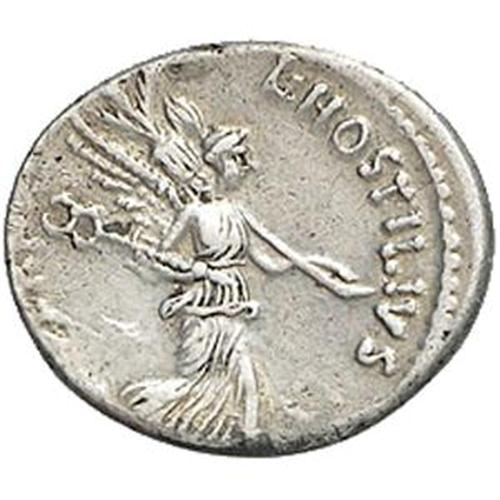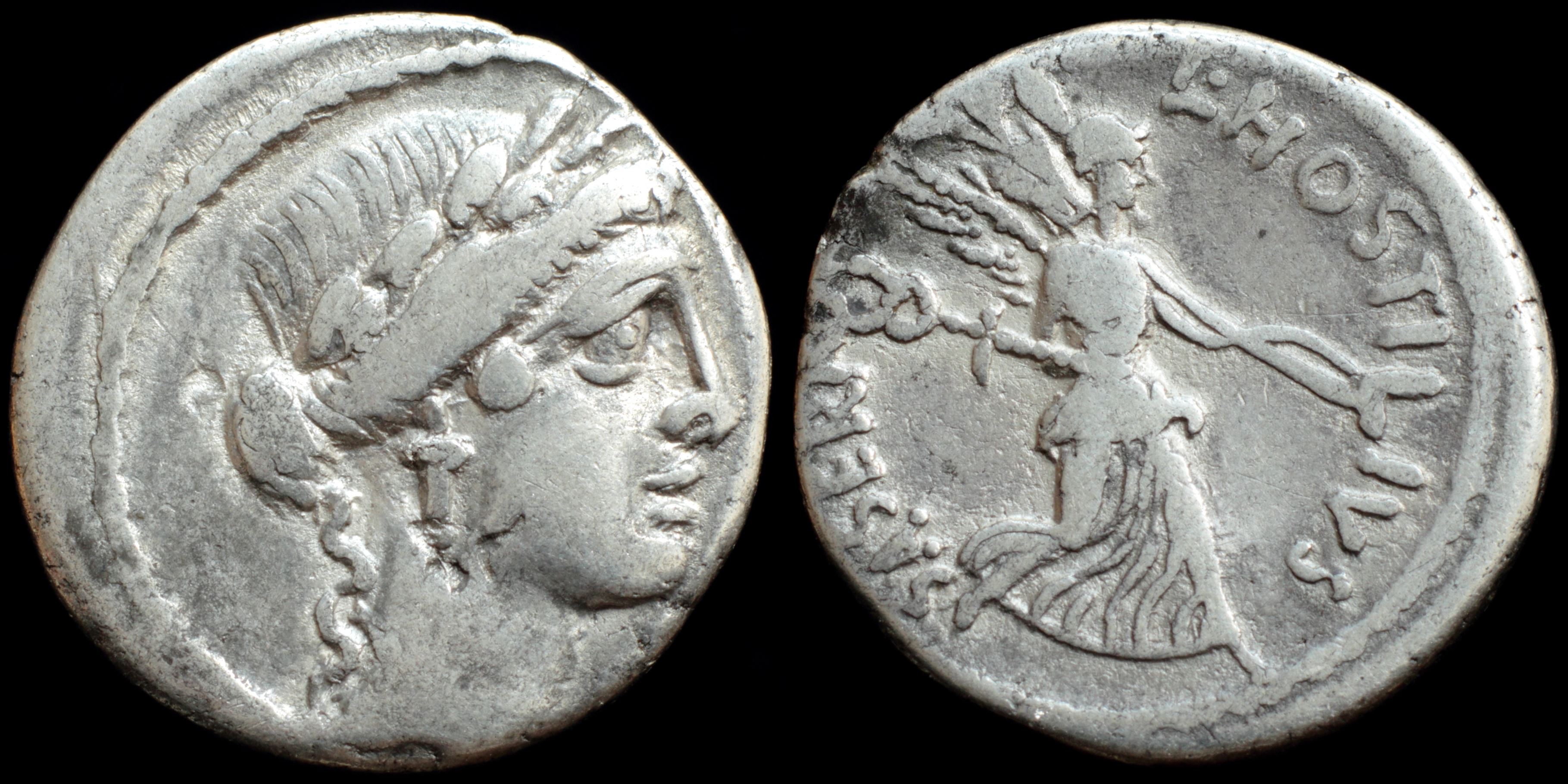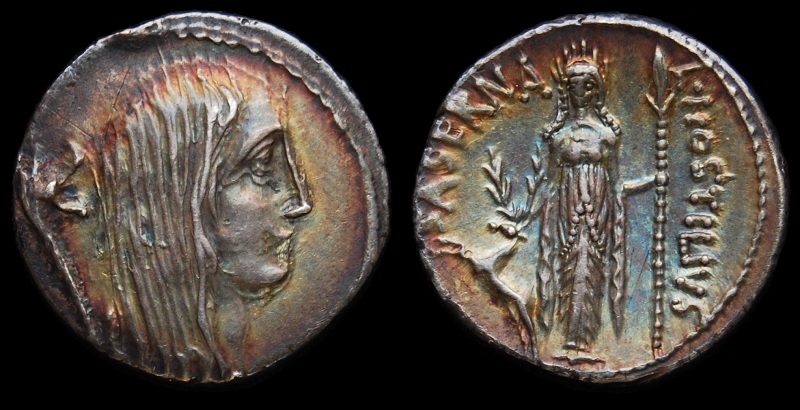L. Hostilius Saserna was one of the moneyers for the year 48 BC - he is not otherwise known.
The gens Hostilia was an ancient family at Rome, which traced its origin to the time of Romulus. The most famous member of the gens was Tullus Hostilius, the third King of Rome; however, all of the Hostilii known from the time of the Republic were plebeians.
Saserna may be a non-Latin nomen or cognomen,
The gens Hostilia was an ancient family at Rome, which traced its origin to the time of Romulus. The most famous member of the gens was Tullus Hostilius, the third King of Rome; however, all of the Hostilii known from the time of the Republic were plebeians.
Saserna may be a non-Latin nomen or cognomen,


Obverse: female (Pietas or Clementia?) head right wearing oak-wreath, cruciform earring, necklace and jewel above her ear, hair collected into a knot behind, and falling down her neck
Reverse: Victory running right, holding caduceus, Gallic trophy and palm fronds, L·HOSTILI
Diameter:
18 mm
Die Orientation: -
Weight: 3.5 g
Die Orientation: -
Weight: 3.5 g
No notes for this coin
Crawford 448/2, Sydenham 951, BMCRR I Rome 3989, RSC I Hostilia 5, Sear CRI 17, SRCV I 417

Obverse: Bare head of Gallia (or Pallor?) right, wearing long, dissheveled hair; carnyx to left.
Reverse: Diana (Artemis) standing facing, laureate, wearing long hair falling down her shoulders and long flowing robes, holding spear in left hand and stag by its antlers in her right; SASERNA upward around left, L • HOSTILIVS downward to right
Diameter:
19 mm
Die Orientation: -
Weight: 3.82 g
Die Orientation: -
Weight: 3.82 g
"The gens Hostilia was an ancient family at Rome, which traced its origin to the time of Romulus. The most famous member of the gens was Tullus Hostilius, the third King of Rome; however, all of the Hostilii known from the time of the Republic were plebeians. Several of the Hostilii were distinguished during the Punic Wars. The first of the family to obtain the consulship was Aulus Hostilius Mancinus in 170 BC. Lucius Hostilius Saserna was a triumvir monetalis in 48 BC.
The obverse figure has not been definitively identified. Some speculate that she is a representation of Gallia, made to represent Julius Caesar's conquest of the area during the Gallic War. This belief is further bolstered by the presence of a carnyx behind the bust.
Another proposition is that the figure is a representation of Pallor, the goddess of fear and paleness. The complexion on the faces of different dies lend plausibility to this theory. There was another god, Pavor, who represented consternation, panic, and dread. Interestingly, Hostilius also struck a coin with a male head (who many bealieve may be a representation of the Gallic chieftain Vercingetorix). This may be an allusion to Tullus Hostilius, who vowed (and presumably later erected) temples to Pallor and Pavor during his war with the Etruscan cities Veii and Fidenae.
Another theory proposed is that Gallia is represented by Pallor, perhaps to show the fear of conquest.
The reverse probably refers to that Artemis was the chief goddess of Massalia, a Greek colony in southern Gaul. In the Civil War, Massalia declared for Pompey and Caesar besieged the city. When it submitted in 49 BC, Caesar allowed it to remain free, but took most of its lands."
Provenance: e-Bay sale (March 2018).
The obverse figure has not been definitively identified. Some speculate that she is a representation of Gallia, made to represent Julius Caesar's conquest of the area during the Gallic War. This belief is further bolstered by the presence of a carnyx behind the bust.
Another proposition is that the figure is a representation of Pallor, the goddess of fear and paleness. The complexion on the faces of different dies lend plausibility to this theory. There was another god, Pavor, who represented consternation, panic, and dread. Interestingly, Hostilius also struck a coin with a male head (who many bealieve may be a representation of the Gallic chieftain Vercingetorix). This may be an allusion to Tullus Hostilius, who vowed (and presumably later erected) temples to Pallor and Pavor during his war with the Etruscan cities Veii and Fidenae.
Another theory proposed is that Gallia is represented by Pallor, perhaps to show the fear of conquest.
The reverse probably refers to that Artemis was the chief goddess of Massalia, a Greek colony in southern Gaul. In the Civil War, Massalia declared for Pompey and Caesar besieged the city. When it submitted in 49 BC, Caesar allowed it to remain free, but took most of its lands."
Provenance: e-Bay sale (March 2018).
Crawford 448/3
